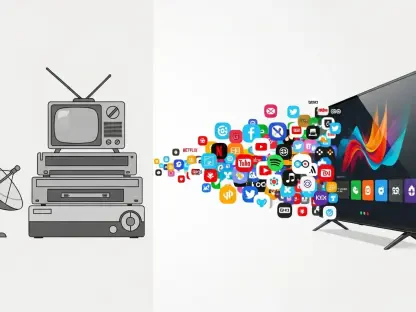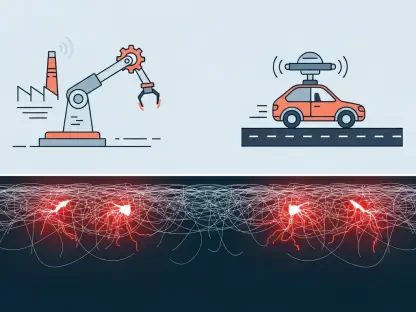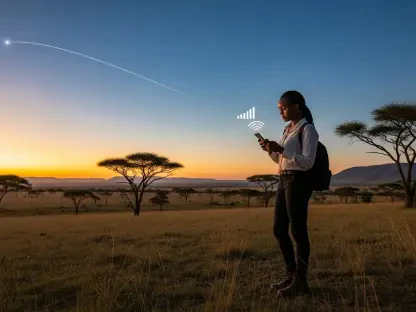In the rapidly shifting landscape of global telecommunications, Ericsson, a powerhouse based in Sweden, is strategically positioning itself to thrive amid complex challenges and emerging opportunities, leveraging its strengths under the astute leadership of CEO Börje Ekholm. The company is tackling a contracting market for radio access network (RAN) products by focusing on regions where competitors like Huawei face exclusion due to security concerns, while also diving deep into artificial intelligence (AI) to drive innovation and efficiency. Despite a reported 6% sales decline in the second quarter of 2024, the firm has demonstrated remarkable resilience with improved profitability and game-changing contracts. This article delves into the multifaceted strategies Ericsson employs to navigate geopolitical tensions, harness cutting-edge technology, and address disparities in 5G deployment, painting a picture of a company determined to maintain its edge in a fiercely competitive industry.
Seizing Opportunities in Restricted Markets
Ericsson has astutely recognized the potential in markets where Huawei and other Chinese vendors are barred due to national security concerns, creating a fertile ground for expansion. Key economies such as the United States, India, Japan, and the United Kingdom stand out as critical regions where Ericsson holds a strong foothold. These areas, driven by policies restricting Chinese technology, have opened doors for Western vendors to dominate. A prime example of this strategic maneuvering is the monumental $14 billion agreement with AT&T finalized in late 2023. This deal not only solidified Ericsson’s presence in the US but also propelled its global RAN market share to an impressive 25.7%, marking a notable gain primarily at the expense of Nokia. Such contracts underscore how geopolitical shifts are reshaping the competitive landscape, allowing Ericsson to capture significant ground in high-value territories where trust in Western technology is paramount, setting a foundation for sustained growth.
Beyond securing high-profile deals, Ericsson’s focus on these Huawei-free markets reflects a broader strategy to outmaneuver rivals in a shrinking industry. The exclusion of Chinese competitors has reduced direct competition in certain regions, enabling Ericsson to prioritize quality over price wars that often characterize markets with low-cost players. This approach is particularly evident in the United States, where the company generated 44% of its second-quarter sales in 2024, highlighting the critical role of these restricted markets in its revenue stream. Moreover, by aligning with national security priorities in these countries, Ericsson not only gains market access but also builds long-term partnerships with governments and major operators. This calculated shift ensures that the company remains a preferred choice in regions wary of foreign tech vulnerabilities, positioning it to leverage policy-driven opportunities while competitors struggle to adapt to similar restrictions elsewhere.
Prioritizing Profitability Amid Sales Challenges
Despite facing a sales downturn to 56.1 billion Swedish kronor (roughly $5.8 billion) in the second quarter of 2024, Ericsson has shown a steadfast commitment to bolstering its financial health through enhanced profitability. The company achieved a remarkable gross margin of 47.5%, an increase of 4.4 percentage points from previous figures, largely by redirecting its focus toward high-margin markets like the United States. This strategic pivot, often referred to as a “mix shift,” prioritizes regions with greater returns over less lucrative ones such as India, where 5G investments have temporarily stalled. By concentrating on areas with stronger economic yield, Ericsson has managed to offset the impact of declining revenues, demonstrating a pragmatic approach to navigating a market that saw global RAN investments drop by 12.5% in recent years, ensuring financial stability in turbulent times.
In addition to market realignment, Ericsson has implemented rigorous cost-cutting measures to fortify its bottom line, even at the cost of significant workforce adjustments. Since the acquisition of Vonage in 2022, the company has reduced its staff by approximately 6%, impacting around 6,000 employees. While such decisions are tough, they have contributed to reversing previous financial setbacks, including a net loss of 11 billion Swedish kronor ($1.1 billion) tied to Vonage impairment charges in 2024, into a profit of 4.4 billion Swedish kronor ($460 million) in the latest quarter. This turnaround reflects a disciplined focus on efficiency, ensuring that resources are allocated to areas with the highest potential for returns. By balancing cost reductions with strategic investments in key markets, Ericsson showcases a model of resilience that prioritizes sustainable growth over short-term revenue spikes in a challenging economic environment.
Driving Innovation Through Artificial Intelligence
Ericsson is embracing artificial intelligence as a cornerstone of its strategy to maintain a competitive edge in the telecommunications sector, integrating it across both internal operations and customer-facing solutions. Within the company, AI is being utilized to streamline complex processes such as network design, significantly reducing operational costs and enhancing efficiency. This internal application allows for faster deployment and optimization of resources, ensuring that Ericsson can respond swiftly to market demands. On the product side, AI is embedded to elevate performance, with notable advancements like a 10% improvement in spectrum efficiency through sophisticated link adaptation algorithms, as highlighted by Per Narvinger, head of the mobile networks business group. This dual focus positions Ericsson as a leader in leveraging technology to address industry challenges.
The broader implications of Ericsson’s AI initiatives signal a transformative shift in how telecom equipment vendors operate and compete in a crowded field. By embedding AI into its offerings, the company not only improves network capabilities for clients but also sets a benchmark for innovation that competitors must match. This technological edge is particularly crucial in markets anticipating a surge in demand for advanced connectivity driven by AI-powered consumer and business applications. Furthermore, the cost savings from AI-driven efficiencies enable Ericsson to reinvest in research and development, fostering a cycle of continuous improvement. As the industry moves toward automation and data-driven decision-making, Ericsson’s proactive adoption of AI ensures it remains at the forefront, ready to meet evolving customer expectations and maintain relevance in a landscape increasingly defined by technological sophistication.
Overcoming Geopolitical Hurdles in Europe
Geopolitical dynamics present a mixed bag of opportunities and obstacles for Ericsson, particularly in the European market where policies on Huawei vary widely despite unified guidelines. The European Union has labeled Huawei a “high-risk vendor,” advocating for its phased exclusion from critical infrastructure, yet enforcement remains inconsistent. In nations like Germany, relaxed regulations permit operators to retain most of Huawei’s RAN equipment with only minor substitutions required by 2029, much to the dismay of Western vendors like Ericsson and Nokia. This lack of uniform action across the region diminishes the potential for companies like Ericsson to capitalize on a Huawei-free environment, limiting market share gains in a continent that should theoretically favor homegrown technology providers amid rising security concerns.
Compounding the frustration, this uneven policy landscape in Europe creates an unpredictable business environment that hampers long-term planning for Ericsson. While some countries adhere strictly to EU recommendations, others prioritize cost over security, allowing Chinese technology to persist in critical networks. This discrepancy not only undermines the competitive advantage of Western firms but also risks fragmenting the European telecom market, potentially delaying broader 5G adoption. For Ericsson, navigating this patchwork of regulations requires diplomatic finesse and strategic patience, as pushing for stricter enforcement could strain relationships with key operators. Despite these challenges, the company remains focused on advocating for a level playing field, hoping that heightened awareness of security risks will eventually align European policies more closely with those in other Huawei-restricted regions, unlocking greater opportunities.
Tapping Into Defense Sector Potential
Ericsson is exploring uncharted territory by eyeing growth in military communications, a sector poised for expansion as NATO members commit to raising defense spending to 5% of GDP by 2035 under international pressure. CEO Börje Ekholm has emphasized the critical role of connectivity in modern defense systems, describing it as a “very good opportunity” for Western vendors unlikely to face competition from Chinese technology due to stringent security requirements. This emerging market represents a significant diversification avenue for Ericsson, leveraging its expertise in secure, high-performance networks to meet the unique demands of military applications, potentially opening a new revenue stream in an area insulated from traditional telecom market fluctuations.
The strategic pivot toward defense communications also aligns with Ericsson’s broader goal of capitalizing on trust in Western technology amid global security concerns. As defense budgets swell, the demand for reliable, secure connectivity solutions is expected to grow, offering a niche where Ericsson can apply its technological prowess in RAN and AI to develop tailored offerings. Unlike consumer markets, the defense sector prioritizes reliability and security over cost, providing a high-margin opportunity that complements Ericsson’s focus on profitability. By positioning itself as a trusted partner in this space, Ericsson could forge long-term contracts with government entities, ensuring stability and growth. This move not only diversifies its portfolio but also reinforces its reputation as a leader in critical infrastructure, capable of adapting to the evolving needs of both civilian and military clients.
Bridging the 5G Readiness Gap
The global disparity in 5G deployment presents a significant hurdle for Ericsson, especially in Europe where infrastructure readiness lags behind leading markets. While the company anticipates that AI-driven innovations, such as smart glasses and augmented reality headsets, will fuel demand for advanced 5G networks with low latency and robust uplink capabilities, Europe’s midband spectrum coverage for standalone 5G remains below 50%. In stark contrast, coverage exceeds 90% in both the United States and China, positioning those regions to capitalize on next-generation services far sooner. This gap risks undermining Europe’s competitiveness in a digital economy increasingly reliant on cutting-edge connectivity, potentially sidelining regional businesses if demand for such services accelerates elsewhere.
Addressing this lag, Ericsson views the European shortfall as both a challenge and a latent opportunity for future growth. The company hopes that the evident disparity will prompt accelerated investments in 5G infrastructure across the continent, driven by the need to keep pace with global trends. Such catch-up efforts could translate into substantial contracts for Ericsson, given its strong presence and expertise in the region. However, the pace of policy and investment decisions remains a variable outside the company’s direct control, requiring a proactive stance in advocating for spectrum allocation and operator upgrades. By aligning with stakeholders to highlight the economic benefits of advanced 5G, Ericsson aims to catalyze action, ensuring that Europe does not fall further behind while positioning itself as the go-to provider for the inevitable infrastructure push that must follow to close this critical technological divide.
Reflecting on Strategic Adaptations
Looking back, Ericsson demonstrated remarkable adaptability in navigating a complex telecommunications environment marked by market contractions and geopolitical intricacies. The company’s efforts to expand in Huawei-free regions, exemplified by the transformative AT&T deal, showcased a keen ability to turn policy-driven exclusions into market share gains. Financial discipline, through a shift to high-margin territories and substantial cost reductions, turned previous losses into profits, reflecting a pragmatic response to industry challenges. The integration of AI into operations and products highlighted a forward-thinking approach, while explorations into military communications opened new horizons. Despite hurdles in Europe’s inconsistent policies and 5G lag, Ericsson’s multifaceted strategies under Börje Ekholm’s guidance laid a robust foundation for resilience, positioning the company to tackle future uncertainties with a blend of innovation and strategic focus.









